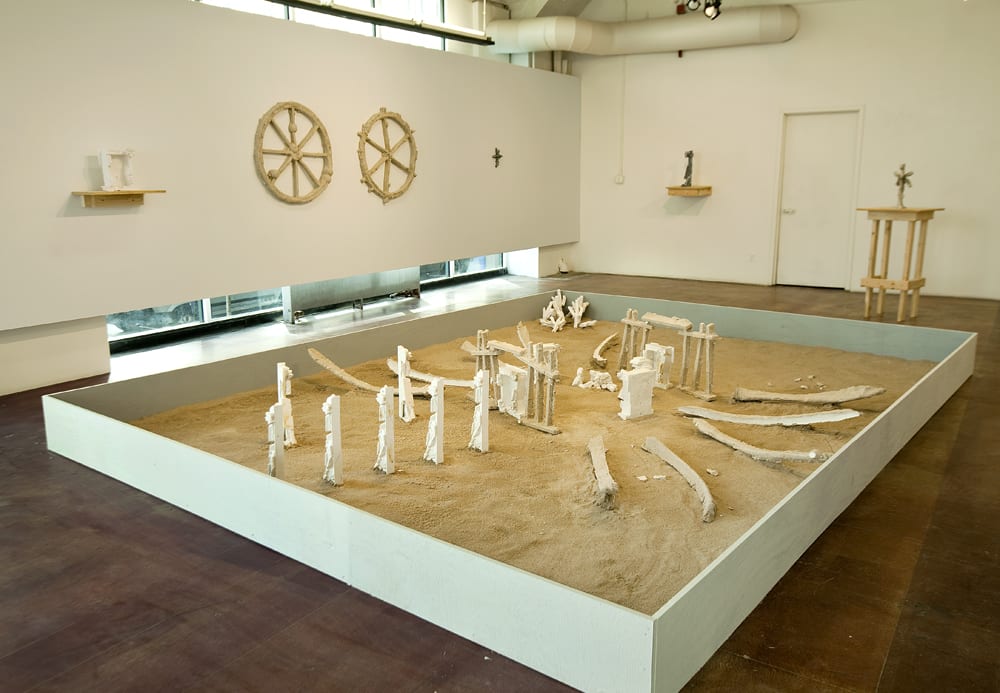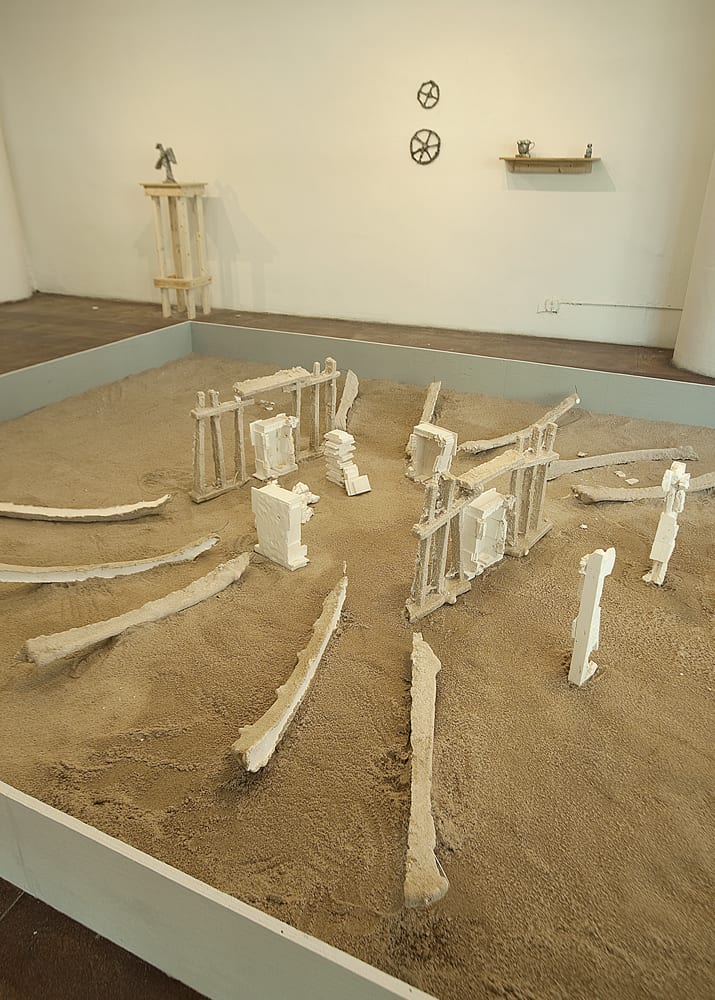What do you regard as sacred?
I think sacredness is a layering process–as a specific location or object is touched or impugned or even just seen by many people over time, it develops a presence, and it occupies an outsized chunk of the spiritual fabric of the universe so that it begins to radiate a certain power which makes it stand out—I think that’s the easy answer. If we believe in spirits, which maybe is a bit harder to stomach these days, then maybe spirits dwell there or they have chosen this specific place or object as a means of effecting absolution or healing. I think probably both possibilities are true.
In what ways do you believe the concept that drives “sacred” objects has changed from the Egyptians to the present?
I think as human beings we have a natural inclination to clutch small talismans and hold them close as producers of luck and safety. We wear them, carry them, or keep them in a special place at home. They may conduct this power of luck and safety the way a paper clip becomes magnetic once it has touched a magnet; anyway, we have always been tied to these things. In Egyptian times they represented a direct bond with the supernatural, and they could, in fact, be the supernatural. The Egyptians bartered with their gods, demons, and spirits; they made deals and transacted with them, sometimes even threatened them. We still do a bit of that, but it’s mostly one-sided begging or prayer. For the most part, we have faith and hope, and we aren’t convinced we will see immediate and direct results from our interaction with the supernatural. Most of the pieces in The Old Gods are explorations of the forms that these early sacred deities took–whether they were crosses, X’s, wheels, cups or all sorts of figures: walking, sitting, etc. I’m looking at the forms that existed before blind faith.

The sandbox of deities feels like a metaphorical playground indicative of the ever-changing roles of those in power (political figures fighting or avoiding the spotlight and celebrities who are worshipped for being famous). How are audiences meant to engage with the sandbox? Is it intended to be interacted with?
Sadly, I am the only one who may play in the sandbox. I am the high priest. When I first met Saul Ostrow, I was obsessed with classical sculptures of hermaphrodites and those half-human/half-pedestal sculptures called “Herms.” We talked about sacredness in ancient sculpture and one of the main ideas we discussed was the concept of sculpture/art that rejects the viewer. Usually, sculpture and painting are positioned so the viewer can see it, and have the best view possible. Ancient ritual art often works from the other direction: the object has its own environment, and sometimes the spectator, either has to contort themselves in order to view the piece, or they aren’t even able/allowed to see it at all! In the ancient temples, in the holy of holies, the deities hung out with each other, sometimes worshippers were carved in stone so that they could silently pay homage to the gods all the time without interruption, but it was the relationship amongst the deities that mattered, not how it looked to the mere mortals who benefitted from the power these gods generated. The Olmecs would bury groupings of jade and other stone gods as if they were meeting and conversing in perpetuity, in small chambers never to be seen by human eyes. The sandbox of deities I’ve created–actually called “The Map Room,” referring to the scene in “Indiana Jones and The Raiders of the Lost Ark”–is a place where the spirits can interact and be organized into sacred arrangements that allow them to converse and generate power. There’s a sense of time passed in the piece, that perhaps these arrangements have declined and some of the power has seeped away. It’s all meant to be a bit nostalgic, like the way I feel about that film.

Objects today are created with a planned obsolescence. Do you feel that they are made with the same intention as past objects of personal devotion? The material has changed from a more permanent stone to a mass produced format.
It’s funny, but planned obsolescence is nothing new. It may be that tools and mechanical objects were made with a greater durability in the past, but many cultures created devotional objects that they felt would wear out after a lifetime of usage–stone deities and magical objects were ritually destroyed and buried after their use-value was exhausted: Cycladic sculptures were smashed and hidden on purpose in very organized ways that indicate it was part of their life-cycle of sacredness. The great circular structures of stone at Gobekli Tepe were carefully and intentionally buried once their creators moved on. We have no idea what they were for or why they were abandoned, but for whatever reason, they were no longer useful to their makers. Even objects that are purportedly eternal, like the Shroud of Turin, the Ark of the Covenant, and various temples and relics, are periodically recreated, re-imbued with spiritual energy, and then presented as a reincarnation of the original.


In the past, the scale of an object would reflect it’s value (for instance the Egyptians and the labor they put into creating monumental tombs to worship their leaders). But you have intentionally made the objects smaller and portable. What motivated that decision?
The Egyptians tended to think big in terms of their human monuments–tombs and images of rulers, and perhaps representations of the gods, but the actual gods themselves, which were worshipped deep in the heart of the temple complexes, were quite small. They were opulent creations of solid gold with jeweled inlays, or, they were treasured supernatural objects, like chunks of meteors. These figures were washed, clothed and fed by armies of priests, who also discerned the will of God through divination and transmitted it to the rest of the community. These Gods were paraded out of the temple on holy days and needed to be relatively easy to spirit away in times of unrest and invasion. When I was in Ethiopia visiting the Ark of the Covenant, I was informed that the Ark was nothing like the one in “Raiders of the Lost Ark” or described in the old testament, it was a small box, albeit of solid gold, that could fit under your arm for easy transportation. In the end, I’m very attracted to this efficient idea of immense sacred power being fit into a relatively small package. That’s why my sculptures are something you can see right in front of you, and feel the desire to pick them up or hug them like a teddy bear. I hug them sometimes.


Culturally, we are devoted to a new object- the smartphone. Since Apple announced its latest trifecta of new shiny iPhones, it’s more evident that the device is sacred to us diurnally. Made of glass, its fragile body is always being cradled as to avoid the cruelty and possible danger of the asphalt. It seems like there is a trajectory that starts with Venus of Willendorf and ends at the iPhone. Do you think there is room in the collective conscious for the sacred?
It’s not like the gods, spirits, and demons are going to disappear because we have smartphones. In one way, we use our smart devices as bizarre little oracles that entertain us and tell us what to do. We’re always using our phones to ask for advice, from each other, from Google. it’s not that different from constantly assessing the signs and symbols in stars, flight patterns of birds, and tea-leaf arrangements that humans used to determine their paths in the past, or praying for guidance for every step you take. On the other hand, I think belief in the sacred arises from fear, Ai Wei Wei would say fear of death, but that’s a bit too specific. The more you study ancient ways of life, the more you see a need for reliance on the supernatural, for a safe birth of your child, for a good harvest, there were a lot fewer things we could control. We can control many aspects of our world right now, and throughout history, you see periods when certain cultures were very insulated from the dangers of the natural world. There was a spike in humanism and decrease in fear-based rituals and reliance on sacred and supernatural powers.

All images photographed by David Riley, courtesy of William Corwin and Geary Contemporary, 2018.
